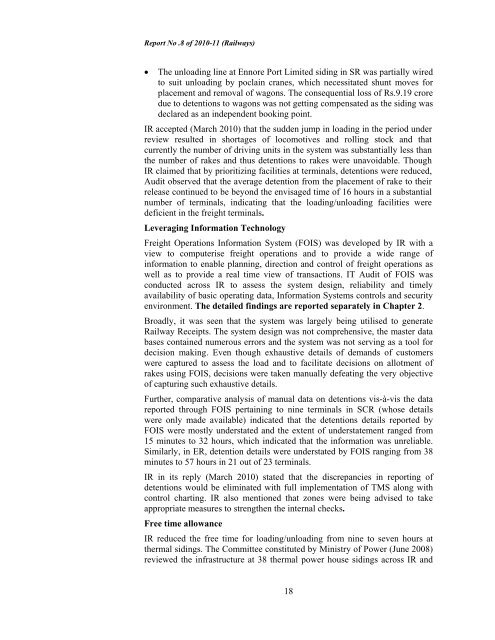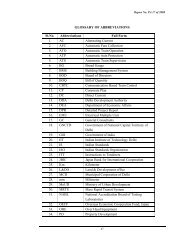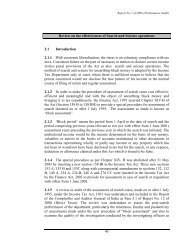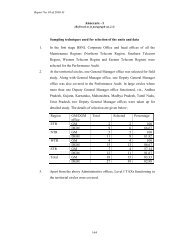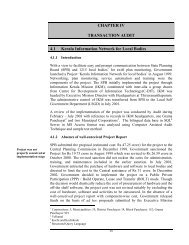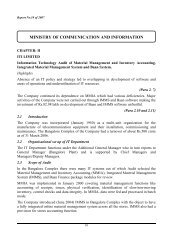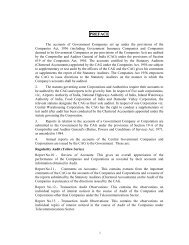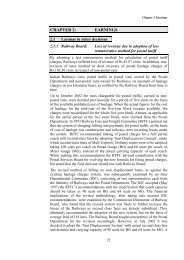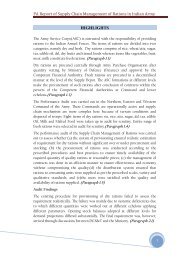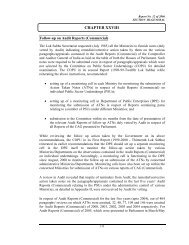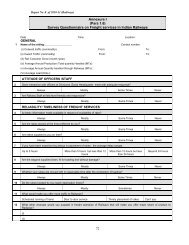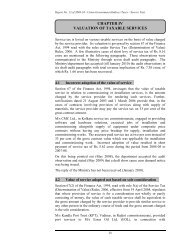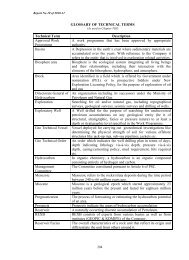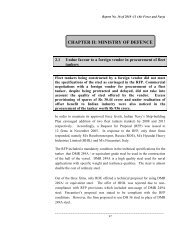Chapter 1 Freight services in Indian Railways - Comptroller and ...
Chapter 1 Freight services in Indian Railways - Comptroller and ...
Chapter 1 Freight services in Indian Railways - Comptroller and ...
Create successful ePaper yourself
Turn your PDF publications into a flip-book with our unique Google optimized e-Paper software.
Report No .8 of 2010-11 (<strong>Railways</strong>)<br />
• The unload<strong>in</strong>g l<strong>in</strong>e at Ennore Port Limited sid<strong>in</strong>g <strong>in</strong> SR was partially wired<br />
to suit unload<strong>in</strong>g by pocla<strong>in</strong> cranes, which necessitated shunt moves for<br />
placement <strong>and</strong> removal of wagons. The consequential loss of Rs.9.19 crore<br />
due to detentions to wagons was not gett<strong>in</strong>g compensated as the sid<strong>in</strong>g was<br />
declared as an <strong>in</strong>dependent book<strong>in</strong>g po<strong>in</strong>t.<br />
IR accepted (March 2010) that the sudden jump <strong>in</strong> load<strong>in</strong>g <strong>in</strong> the period under<br />
review resulted <strong>in</strong> shortages of locomotives <strong>and</strong> roll<strong>in</strong>g stock <strong>and</strong> that<br />
currently the number of driv<strong>in</strong>g units <strong>in</strong> the system was substantially less than<br />
the number of rakes <strong>and</strong> thus detentions to rakes were unavoidable. Though<br />
IR claimed that by prioritiz<strong>in</strong>g facilities at term<strong>in</strong>als, detentions were reduced,<br />
Audit observed that the average detention from the placement of rake to their<br />
release cont<strong>in</strong>ued to be beyond the envisaged time of 16 hours <strong>in</strong> a substantial<br />
number of term<strong>in</strong>als, <strong>in</strong>dicat<strong>in</strong>g that the load<strong>in</strong>g/unload<strong>in</strong>g facilities were<br />
deficient <strong>in</strong> the freight term<strong>in</strong>als.<br />
Leverag<strong>in</strong>g Information Technology<br />
<strong>Freight</strong> Operations Information System (FOIS) was developed by IR with a<br />
view to computerise freight operations <strong>and</strong> to provide a wide range of<br />
<strong>in</strong>formation to enable plann<strong>in</strong>g, direction <strong>and</strong> control of freight operations as<br />
well as to provide a real time view of transactions. IT Audit of FOIS was<br />
conducted across IR to assess the system design, reliability <strong>and</strong> timely<br />
availability of basic operat<strong>in</strong>g data, Information Systems controls <strong>and</strong> security<br />
environment. The detailed f<strong>in</strong>d<strong>in</strong>gs are reported separately <strong>in</strong> <strong>Chapter</strong> 2.<br />
Broadly, it was seen that the system was largely be<strong>in</strong>g utilised to generate<br />
Railway Receipts. The system design was not comprehensive, the master data<br />
bases conta<strong>in</strong>ed numerous errors <strong>and</strong> the system was not serv<strong>in</strong>g as a tool for<br />
decision mak<strong>in</strong>g. Even though exhaustive details of dem<strong>and</strong>s of customers<br />
were captured to assess the load <strong>and</strong> to facilitate decisions on allotment of<br />
rakes us<strong>in</strong>g FOIS, decisions were taken manually defeat<strong>in</strong>g the very objective<br />
of captur<strong>in</strong>g such exhaustive details.<br />
Further, comparative analysis of manual data on detentions vis-à-vis the data<br />
reported through FOIS perta<strong>in</strong><strong>in</strong>g to n<strong>in</strong>e term<strong>in</strong>als <strong>in</strong> SCR (whose details<br />
were only made available) <strong>in</strong>dicated that the detentions details reported by<br />
FOIS were mostly understated <strong>and</strong> the extent of understatement ranged from<br />
15 m<strong>in</strong>utes to 32 hours, which <strong>in</strong>dicated that the <strong>in</strong>formation was unreliable.<br />
Similarly, <strong>in</strong> ER, detention details were understated by FOIS rang<strong>in</strong>g from 38<br />
m<strong>in</strong>utes to 57 hours <strong>in</strong> 21 out of 23 term<strong>in</strong>als.<br />
IR <strong>in</strong> its reply (March 2010) stated that the discrepancies <strong>in</strong> report<strong>in</strong>g of<br />
detentions would be elim<strong>in</strong>ated with full implementation of TMS along with<br />
control chart<strong>in</strong>g. IR also mentioned that zones were be<strong>in</strong>g advised to take<br />
appropriate measures to strengthen the <strong>in</strong>ternal checks.<br />
Free time allowance<br />
IR reduced the free time for load<strong>in</strong>g/unload<strong>in</strong>g from n<strong>in</strong>e to seven hours at<br />
thermal sid<strong>in</strong>gs. The Committee constituted by M<strong>in</strong>istry of Power (June 2008)<br />
reviewed the <strong>in</strong>frastructure at 38 thermal power house sid<strong>in</strong>gs across IR <strong>and</strong><br />
18


